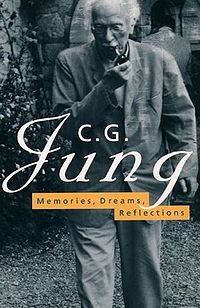Book: Memories, Dreams and Reflections
Many folks interested in Jung think that this is the best of the books about him; when I read it in my twenties — knowing nothing about Jung — I found it a bit strange and hard to follow. I don’t think it is necessarily the best book to start reading about Jung (which is probably Man and His Symbols), but it is essential reading to understand his life and his view of his life. It is particularly interesting for an autobiography because it is really about the internal events of a life, much different than the usual book about the external events of person’s life.
Memories, Dreams, Reflections (original German title Erinnerungen Träume Gedanken) is a partially autobiographical book by Swiss psychologist Carl Jung and associate Aniela Jaffé. The book details Jung’s childhood, his personal life, and exploration into the psyche.
In 1956 Kurt Wolff, publisher and owner of Pantheon Books, expressed a desire to publish a biography of Jung’s life. Dr. Jolande Jacobi, an associate of Jung, suggested Aniela Jaffé be the biographer. Jung was very reticent to cooperate with Jaffé in the beginning, but because of his growing conviction of the work’s importance, he became more engrossed in the project and began writing part of the text himself. In total, Jung wrote the first three chapters on his childhood and early adulthood, the chapter entitled “Late Thoughts,” and the chapter on his travels to Kenya and Uganda.[2] The rest of the text was written by Jaffé through direct conversation with Jung.
The content and layout of the yet-unpublished manuscripts was heavily disputed. Jung’s family, in the interest of keeping Jung’s private life from the public eye, pushed for deletions and other changes. Those involved in its publication demanded massive cuts in the text’s length to keep the price of printing down. Jaffé herself was accused of censorship when she began exercising her Jung-appointed authority as editor to reword some of his thoughts on Christianity she deemed too controversial. Eventually, the disputed text (including a chapter entitled “Encounters” detailing some of Jung’s friend and acquaintanceships with various people) was integrated into other chapters and Pantheon Books stopped their push for further deletions after Jaffé and others’ protest. The book was finally published in 1963, two years after Jung’s death. It has remained in print ever since.

